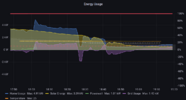Hi, I've had a Powerwall Plus installed with 8.6kW peak of solar since November. I've noticed a problem from time to time, I've contacted both the installer and Tesla and so far it's not resolved, it still happens.
The problem is that, from time to time, my battery temporarily stops charging or discharging. Frequently this means my battery is well above my reserve limit, yet it will not discharge and I instead pull energy from the grid. Occasionally, this means that I end up overproducing solar and selling energy back to the grid instead of charging the battery.
I've logged into to TeslaOne to see if there are any faults, in general I do not have any. Well I take that back, Tesla did tell me one time I do have high voltage from the utility. I can corrobate this, sometimes I see 252-254VAC on the line, which is almost 5% above 240VAC.
This happens perhaps once or twice a week, it's hard to definitively give a cause, but sometimes it happens when a hard load kicks on like my AC. In fact, that is the state now. At 6PM, my AC unit kicked on, and right around that time, my Powerwall stopped providing power. Right now it's sitting at 100% and not discharging, instead the grid is providing power. (See attached graph).
When I first called Tesla, a tier one person looked at the logs and said my coolant was low, and recommended I contact my installer to refill it. (Bear in mind this unit was just installed 6 months ago). I found this hard to believe, I asked why it would be low if it was just installed and I see no evidence of leaking. She said they deliberately do not fill them full at manufacture. I found this even less plausible, especially since my installer had never filled any coolant during installs.
Anyway, my installer did come out and look at a few things, they found some loose neutrals in my panel, and also noticed the highish voltage that Tesla did. But the problem never really went away.
Occasionally resetting the system gets it working again, but sometimes not. Usually I just have to wait. It may take 30 minutes or 8 hours before the battery starts discharging again.
Has anyone else had a problem like this?
The problem is that, from time to time, my battery temporarily stops charging or discharging. Frequently this means my battery is well above my reserve limit, yet it will not discharge and I instead pull energy from the grid. Occasionally, this means that I end up overproducing solar and selling energy back to the grid instead of charging the battery.
I've logged into to TeslaOne to see if there are any faults, in general I do not have any. Well I take that back, Tesla did tell me one time I do have high voltage from the utility. I can corrobate this, sometimes I see 252-254VAC on the line, which is almost 5% above 240VAC.
This happens perhaps once or twice a week, it's hard to definitively give a cause, but sometimes it happens when a hard load kicks on like my AC. In fact, that is the state now. At 6PM, my AC unit kicked on, and right around that time, my Powerwall stopped providing power. Right now it's sitting at 100% and not discharging, instead the grid is providing power. (See attached graph).
When I first called Tesla, a tier one person looked at the logs and said my coolant was low, and recommended I contact my installer to refill it. (Bear in mind this unit was just installed 6 months ago). I found this hard to believe, I asked why it would be low if it was just installed and I see no evidence of leaking. She said they deliberately do not fill them full at manufacture. I found this even less plausible, especially since my installer had never filled any coolant during installs.
Anyway, my installer did come out and look at a few things, they found some loose neutrals in my panel, and also noticed the highish voltage that Tesla did. But the problem never really went away.
Occasionally resetting the system gets it working again, but sometimes not. Usually I just have to wait. It may take 30 minutes or 8 hours before the battery starts discharging again.
Has anyone else had a problem like this?



